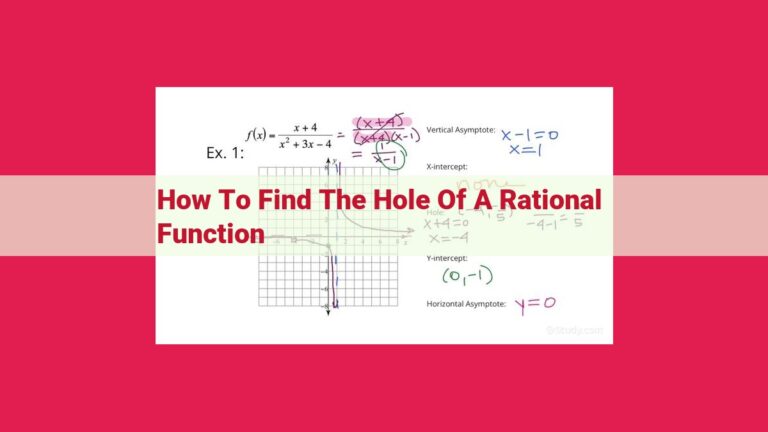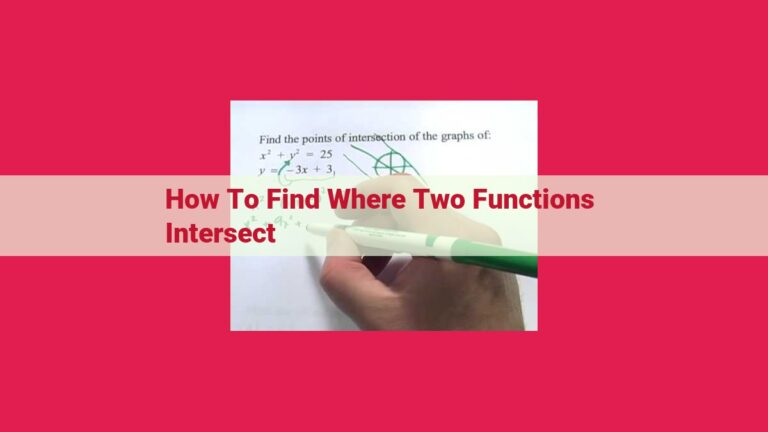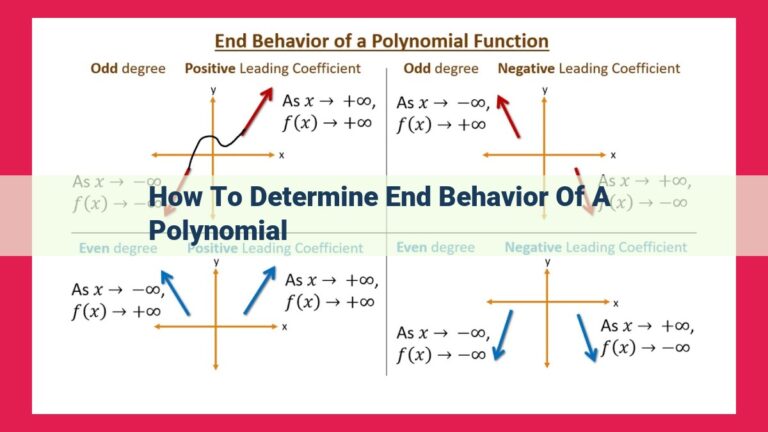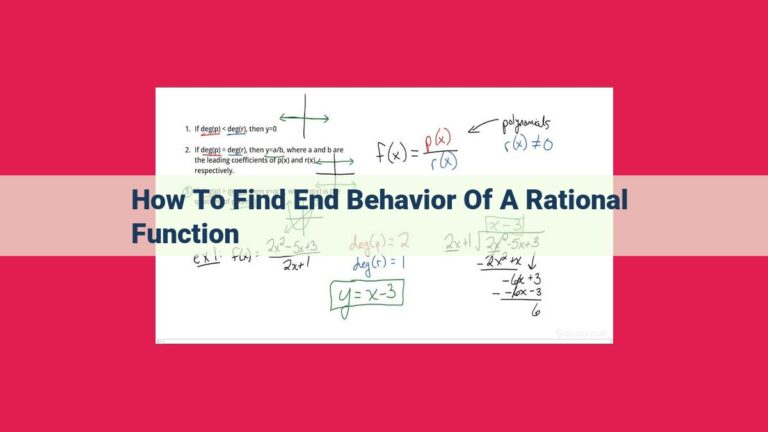Identifying And Understanding Linear Equations: A Comprehensive Guide
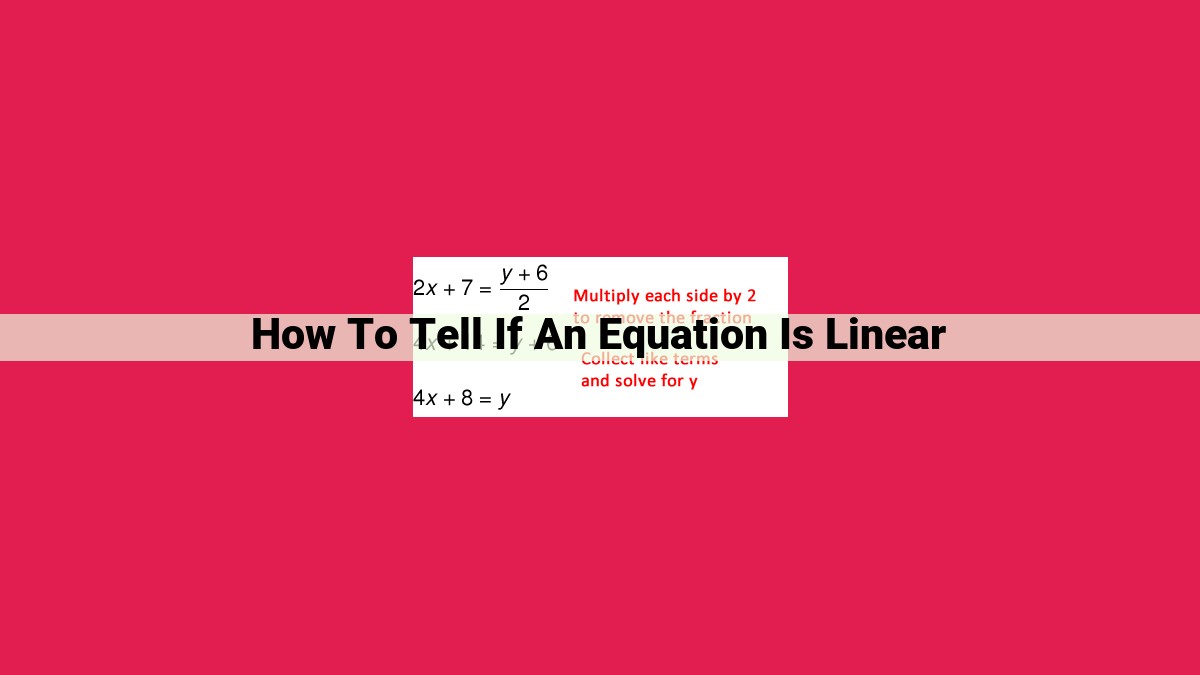
To determine if an equation is linear, examine its characteristics. Linear equations are first-degree polynomial equations, represented as Ax + By = C in standard form. They have a constant slope (rate of change) represented by m. The y-intercept is the point where the line intersects the y-axis, given by b. Alternatively, the slope-intercept form y = mx + b clearly shows the slope and y-intercept. If an equation meets these criteria, it is linear. For instance, y = 2x + 3 is linear, while y = x^2 is non-linear.
Unlocking the Secrets of Linear Equations: A Journey to Mathematical Mastery
In the realm of mathematics, linear equations hold a fundamental place, serving as the cornerstone for a plethora of applications in science, engineering, economics, and beyond. Identifying and understanding these equations is not just a mathematical exercise; it’s a key that unlocks doors to a world of knowledge.
Why is identifying linear equations so important? Imagine this: You’re at a grocery store, and you want to compare the prices of two different brands of cereal. The first brand costs $3 per box, while the second brand costs $4 per box. How can you determine which one is a better deal for a given quantity? This is where linear equations come into play.
Defining Linear Equations: A Look Under the Hood
Linear equations are first-degree polynomial equations, meaning they’re equations of the form Ax + By = C, where A, B, and C are constants and x and y are variables. These equations represent straight lines on a graph, and they possess two crucial characteristics: slope and y-intercept.
Unveiling the Secrets of Slope and Y-Intercept
Slope is the rate of change or gradient of a line. It tells us how much the line rises or falls for each unit increase in x. Y-intercept is the point where the line intersects the y-axis, indicating the value of y when x is equal to zero.
Identifying these key characteristics allows us to interpret and manipulate linear equations effortlessly. For instance, if we know the slope of a line, we can predict how the line will behave as x increases or decreases. Similarly, the y-intercept provides valuable information about the starting point of the line.
State the key characteristics of linear equations.
Identifying Linear Equations: A Comprehensive Guide
In the realm of mathematics, equations are like blueprints that describe relationships between variables. Among the many types of equations, linear equations stand out for their simplicity and numerous real-world applications. Identifying them is crucial for solving problems and unlocking their power.
Key Characteristics of Linear Equations
- First-Degree Polynomial: Linear equations are characterized by their first-degree polynomial form. This means they have variables raised to the first power only and no higher exponents.
- Straight Line: When graphed, linear equations produce straight lines. This is because their relationship is linear, with a constant rate of change.
- Constant Rate of Change: The slope of a linear equation represents the constant rate of change. It measures how much the dependent variable (usually y) changes for every unit increase in the independent variable (usually x).
- Y-Intercept: The y-intercept is the point where the line intersects the y-axis. It indicates the value of the dependent variable when the independent variable is zero.
By understanding these key characteristics, you can confidently identify linear equations and harness their versatility in solving a wide range of mathematical and real-life problems.
Understanding Linear Equations: A Guide to Identifying Essential Characteristics
In the vast world of mathematics, linear equations hold a fundamental place, representing a significant chapter in our understanding of algebra. These equations are ubiquitous in real-life applications, from the trajectory of a thrown ball to the growth curve of a population. Identifying linear equations is crucial for solving problems and extracting valuable insights from data.
One of the most pivotal characteristics of a linear equation is its slope, also known as the gradient. The slope describes the rate of change along a line, indicating how the dependent variable (y) changes with respect to the independent variable (x) as we move along the line.
Mathematically, the slope is calculated by finding the ratio of the change in (y) over the change in (x):
Slope (m) = Δy / Δx
where Δy represents the vertical change and Δx represents the horizontal change between two points on the line.
For instance, consider a line that passes through the points ((2, 5)) and ((4, 9)). The change in (y) (Δy) is 9-5 = 4, and the change in (x) (Δx) is 4-2 = 2. Therefore, the slope of this line would be:
Slope (m) = Δy / Δx = 4 / 2 = 2
This indicates that for every increase of 1 unit in (x), the corresponding value of (y) increases by 2 units.
Identifying Linear Equations: A Comprehensive Guide
Linear equations are fundamental mathematical concepts with numerous real-world applications. Their simplicity and versatility make them crucial for problem-solving and analytical thinking. Understanding how to identify linear equations is essential for harnessing their power.
Slope: The Rate of Change
One key characteristic of linear equations is their constant rate of change, known as the slope. The slope is the gradient of a line, indicating how much the line rises or falls for each unit of horizontal movement. It is often denoted by the variable m.
To calculate the slope from two points, (x1, y1) and (x2, y2), on the line, use the formula:
Slope (m) = (y2 - y1) / (x2 - x1)
Y-Intercept: The Starting Point
Another important feature of linear equations is the y-intercept. This is the point where the line intersects the y-axis, i.e., when x is 0. The y-intercept is often represented by the variable b.
To find the y-intercept from the equation of a line in the form y = mx + b, simply plug in x = 0 and solve for y.
Linear Equations: A Balancing Act
Linear equations are first-degree polynomial equations, meaning they have a constant rate of change and a non-zero y-intercept. They are typically represented in the form Ax + By = C, where A, B, and C are constants.
Standard Form: A Common Denominator
The standard form of a linear equation is Ax + By = C. This format is useful for performing algebraic operations, such as adding, subtracting, or multiplying equations.
Slope-Intercept Form: Slope and Y-Intercept at a Glance
The slope-intercept form of a linear equation is y = mx + b. This form explicitly displays the slope m and the y-intercept b, making it easy to visualize the line.
Point-Slope Form: A Line Defined by a Point and Slope
The point-slope form of a linear equation is y - y1 = m(x - x1), where (x1, y1) is a known point on the line and m is the slope. This form is useful for writing an equation when given a point and the slope.
Distinguishing Linear from Non-Linear
To determine if an equation is linear, check if it is in the form Ax + By = C. If it is, the equation is linear. Otherwise, it is non-linear. For example, y = x^2 is non-linear because it contains a squared term.
Identifying linear equations is a fundamental skill for problem-solving and data analysis. By understanding the key characteristics of linear equations, such as slope, y-intercept, and various forms, you can leverage their power to model real-world phenomena, make predictions, and draw meaningful conclusions.
The Y-Intercept: Where the Line Meets the Y-Axis
In the world of linear equations, the y-intercept deserves its own special spotlight. Picture a line dancing across a graph, its graceful movements guiding the eye up and down. The y-intercept is the magical point where this line takes a pause and kisses the y-axis.
Imagine the y-axis as the vertical backbone of our graph. It stretches upwards, forever reaching towards the heavens. The x-axis, on the other hand, acts as a horizontal base, a firm foundation upon which the line can balance.
The y-intercept is the exact spot where the line intersects this y-axis. It’s the point where the line breaks free from the clutches of the x-axis and takes a leap upwards. It’s the starting point, the point of origin, the place where the line begins its linear journey.
To find the y-intercept, we simply look at the equation of our line. It’s the constant term, the one that doesn’t have an x variable hanging around. For example, in the equation y = 2x + 3, the y-intercept is 3. That means the line starts its dance at point (0, 3), three units above the origin.
The y-intercept is crucial for understanding our line’s behavior. It tells us how high the line is perched when x is zero. It gives us the starting value, the foundation upon which the line’s journey unfolds.
Unveiling the Secrets of Linear Equations: A Comprehensive Guide
In the realm of mathematics, linear equations hold a special place, serving as the foundation for countless real-world applications. Identifying linear equations is the key to unlocking their power, and it all starts with understanding their unique characteristics.
Slope: Measuring the Line’s Steepness
Every linear equation is defined by its slope, which represents the rate of change along the line. Imagine a line climbing a hill; its slope determines how quickly it ascends. The slope can be calculated using two points on the line, providing a numerical value that describes its steepness.
Y-Intercept: Where It All Begins
Another crucial aspect of linear equations is the y-intercept, the point where the line crosses the y-axis. Think of it as the starting point, the point on the y-axis where the line begins its journey. The y-intercept can be found directly from the equation of the line, providing valuable information about its position.
Expressing Linear Equations in Different Forms
Linear equations can be represented in various forms, each with its own advantages. The standard form, Ax + By = C, is widely used for algebraic manipulations. The slope-intercept form, y = mx + b, makes it easy to see the slope and y-intercept at a glance. The point-slope form, y – y1 = m(x – x1), is useful when you’re given a specific point and slope.
Identifying Linear Equations
Recognizing linear equations is essential for solving them effectively. Look for the following telltale signs:
- The equation is a first-degree polynomial, meaning it has no terms with exponents greater than one.
- It can be written in one of the standard forms mentioned above.
- It has a constant slope throughout the entire line.
Mastering the art of identifying linear equations opens up a world of possibilities. These equations are indispensable tools in fields such as physics, economics, and engineering. From describing motion to predicting growth patterns, linear equations provide a powerful lens for understanding our world.
Definition of linear equations as first-degree polynomial equations.
Identifying Linear Equations: A Comprehensive Guide
Linear equations are fundamental building blocks of mathematics and play a crucial role in various fields. From everyday problem-solving to complex scientific models, understanding linear equations empowers us to analyze and solve real-world scenarios.
Characteristics of Linear Equations:
Linear equations possess distinct characteristics that set them apart from other types of equations. They are first-degree polynomial equations, which means they contain only one variable raised to the first power. This simplicity makes them easy to graph and manipulate. Linear equations also exhibit a constant rate of change, known as the slope.
Slope: The Gradient of a Line
The slope of a line measures its incline or steepness. It represents the rate at which the y-coordinate changes as the x-coordinate increases. Slope can be calculated from two points on the line using the formula:
Slope = (Change in y) / (Change in x)
Y-Intercept: The Point Where the Line Crosses the Y-Axis
The y-intercept of a line is the point where it intersects the y-axis. This point represents the value of y when x is zero. The y-intercept can be found from the equation of the line by setting x to zero and solving for y.
Standard Form of Linear Equations
Linear equations are often expressed in standard form, which follows the format:
Ax + By = C
Where A, B, and C are constants. Standard form is useful for solving and manipulating linear equations and making comparisons between different lines.
Slope-Intercept Form: The Equation of a Line with Known Slope and Intercept
The slope-intercept form of a linear equation is:
y = mx + b
Where m is the slope and b is the y-intercept. This form is particularly helpful when you know the slope and y-intercept of the line and want to write its equation quickly.
Point-Slope Form: The Equation of a Line Passing Through a Known Point
The point-slope form of a linear equation is:
y - y1 = m(x - x1)
Where (x1, y1) is a known point on the line and m is the slope. This form is useful when you want to write the equation of a line given a point and its slope.
Determining if an Equation is Linear
To determine if an equation is linear, check if it meets the following criteria:
- It is a first-degree polynomial equation.
- It can be written in standard form (Ax + By = C).
Understanding linear equations is essential for a wide range of mathematical and real-world applications. Whether it’s modeling a budget, forecasting a sales trend, or simply solving a daily problem, linear equations provide a powerful tool for analyzing and predicting outcomes. By mastering the concepts outlined in this guide, you’ll be well-equipped to tackle any equation that comes your way.
Understanding Linear Equations: A Guide to Identifying and Exploring the Basics
Identifying linear equations is a crucial skill in mathematics, enabling us to solve a wide range of problems and model real-life scenarios. In this article, we will delve into the fundamentals of linear equations, exploring their key characteristics, and equipping you with the tools to confidently identify them.
Defining Linearity
A linear equation is a first-degree polynomial equation that can be expressed in the form:
Ax + By = C
where A, B, and C are constants, and x and y are variables. The key feature of a linear equation is that the relationship between x and y is linear, meaning it can be represented by a straight line on a graph.
Exploring Slope and Y-Intercept
Slope
The slope (m) of a line represents the rate of change or gradient as x changes. It is calculated by determining the change in y (Δy) divided by the change in x (Δx) between any two distinct points on the line:
m = Δy / Δx
Y-Intercept
The y-intercept (b) is the point where the line intersects the y-axis. It is found by substituting x = 0 into the equation of the line, giving us:
b = C/A
Standard Form and Slope-Intercept Form
Standard Form
The standard form of a linear equation is Ax + By = C. This form allows for easy manipulation and solving of equations.
Slope-Intercept Form
Slope-intercept form is another common way to express linear equations:
y = mx + b
where m represents the slope and b represents the y-intercept. This form is particularly convenient for identifying slope and y-intercept directly from the equation.
Identifying Linear Equations
To determine if an equation is linear, follow these criteria:
- The equation must be of first degree (the highest power of x and y is 1).
- The equation must not contain any squared, cubed, or higher powers of x or y.
- The equation cannot contain trigonometric functions (e.g., sin, cos, tan).
Understanding linear equations is a foundational skill in mathematics, opening up a world of problem-solving and modeling possibilities. By mastering the concepts of slope, y-intercept, and different equation forms, you can confidently identify and work with linear equations, empowering you to tackle a wide range of mathematical challenges and explore the world of linear relationships.
Unveiling the Secrets of Linear Equations
In the realm of mathematics, linear equations reign supreme, unveiling hidden relationships between variables. These equations play a pivotal role in unraveling countless mysteries, from predicting the trajectory of a projectile to modeling the growth of a population. Understanding the characteristics and key elements of linear equations is crucial for unlocking their power.
Slope: The Gradient of Change
Envision a line gliding across a graph. The slope of this line measures how steeply it ascends or descends. Mathematically, slope represents the rate of change in the y-value for each unit change in the x-value.
Calculating the Slope:
Imagine two points, (x1, y1) and (x2, y2), lying on the line. The slope (m) can be determined using the formula:
m = (y2 - y1) / (x2 - x1)
Y-Intercept: The Starting Point
The y-intercept of a line is the point where it intersects the y-axis. It reveals the initial value of y when x equals zero.
Finding the Y-Intercept:
To extract the y-intercept (b) from the equation of a line, simply set x to zero:
y = mx + b
b = y when x = 0
Standard Form: A Consistent Representation
The standard form of a linear equation, Ax + By = C, presents the equation in a consistent and recognizable format. It allows for easy manipulation and comparison of different equations.
Example:
Consider the equation 2x + 3y = 6. This equation is in standard form, with coefficients A = 2, B = 3, and C = 6.
Unveiling the Essence of Linear Equations: A Comprehensive Guide
Identifying linear equations is crucial in mathematics, as they form the bedrock of numerous real-world applications. These equations exhibit distinct characteristics that empower us to solve problems and analyze relationships effectively.
Slope: The Rate of Change
The slope of a linear equation defines the gradient or rate of change, indicating how steeply it ascends or descends. Calculating the slope using two points on the line unveils this crucial attribute.
Y-Intercept: Where the Line Meets the Y-Axis
The y-intercept signifies the point where the line intersects the y-axis. It represents the value of the dependent variable when the independent variable is zero.
Linear Equations: A First-Degree Encounter
Linear equations are first-degree polynomial equations that take the form Ax + By = C. They possess a linear relationship, meaning their graphs form straight lines.
Standard Form: The Foundation for Manipulation
The standard form of a linear equation, Ax + By = C, provides a consistent framework for solving and manipulating equations. It allows us to isolate variables and perform various algebraic operations with ease.
Slope-Intercept Form: Unveiling Slope and Y-Intercept
The slope-intercept form, y = mx + b, explicitly reveals the slope (m) and y-intercept (b) of the equation. This format facilitates graphing and interpreting the relationship between variables.
Point-Slope Form: Connecting Points and Slopes
The point-slope form, y – y1 = m(x – x1), utilizes a specific point (x1, y1) and the slope (m) to write the equation of a line. It’s particularly useful when given specific coordinates.
Determining Linearity: A Diagnostic Approach
Identifying linear equations involves examining their form and characteristics. Linear equations exhibit a linear relationship, meaning their graphs form straight lines. Equations that do not fit this criterion are non-linear.
Mastering the identification and manipulation of linear equations unlocks a wealth of applications in diverse fields, such as physics, engineering, and economics. Their ability to describe real-world phenomena makes them invaluable tools for understanding and solving complex problems.
Identifying Linear Equations: A Step-by-Step Guide
In the realm of mathematics, linear equations are like humble yet powerful tools that help us unravel countless real-world problems. Mastering their identification is crucial to harness their potential. Let’s embark on a journey to explore the key characteristics and forms of linear equations.
Slope-Intercept Form: The Most Convenient
Among the various ways to write a linear equation, the slope-intercept form, expressed as y = mx + b, reigns supreme in terms of readability and ease of use. It’s like having a personal guide that leads us straight to the critical information we need.
The slope (m), represented by the coefficient of x, tells us how steeply the line rises or falls. Think of it as the gradient of the line, the rate at which the y-value changes for every unit change in x.
The y-intercept (b), on the other hand, is where the fun begins. It’s the point where our line kisses the y-axis. Whether it’s a positive, negative, or zero value, the y-intercept gives us insights into where the line starts its journey.
The beauty of the slope-intercept form lies in its ability to provide a quick snapshot of both slope and y-intercept without any complicated calculations. It’s like having all the essential information at our fingertips, ready to unravel any linear equation that crosses our path.
How to identify the slope (m) and y-intercept (b) from the equation.
Unveiling the Secrets of Linear Equations: A Guide to Slope and Y-Intercept
When embarking on the mathematical journey of linear equations, understanding the concepts of slope and y-intercept is paramount. These fundamental elements provide a roadmap to comprehending the intricacies of these deceptively simple yet powerful equations.
For starters, think of slope as the rate at which a line ascends or descends. It measures the gradient or how much the line “tilts” as you move along its path. To calculate slope, simply divide the change in y (the vertical difference) by the change in x (the horizontal difference) between any two points on the line.
Analogous to slope is the y-intercept, the point where the line intersects the y-axis. This value reflects the starting point of the line vertically. To extract the y-intercept from the equation of a line, simply set x to zero (since it represents the horizontal distance from the origin) and solve for y.
A linear equation, in essence, is a first-degree polynomial equation, meaning its highest exponent is one. These equations take the standard form Ax + By = C, where A, B, and C are constants. For example, the equation 2x + 3y = 6 exemplifies a linear equation.
To identify the slope and y-intercept from this standard form, the equation must be transformed into slope-intercept form: y = mx + b. Here, m represents the slope and b represents the y-intercept. To convert the standard form to slope-intercept form, isolate y on one side of the equation: y = (-A/B)x + (C/B). The coefficient of x, in this case, (-A/B), corresponds to the slope, and the constant term, (C/B), corresponds to the y-intercept.
In summary, delving into the mysteries of linear equations requires a firm grasp of slope and y-intercept. Slope measures the line’s inclination, while the y-intercept unveils its vertical starting point. To uncover these secrets, harness the power of the standard and slope-intercept forms, transforming equations to unveil their hidden insights.
Unveiling the Secrets of Linear Equations: A Guide for Beginners
Linear equations are like treasure maps, guiding us through the labyrinth of mathematical problems. They hold the secrets to solving real-world dilemmas, unlocking doors to understanding everything from finances to physics. Today, we embark on a thrilling adventure to decipher these equations, deciphering their enigmatic nature and arming you with the tools to conquer any mathematical challenge.
Slope: The Gradient of Change
Imagine a mountain slope, a gradual incline that guides your path. Slope, in the realm of linear equations, plays a similar role. It measures the rate of change, how quickly a line rises or falls as you move along its length. By calculating the slope from two points on the line, you gain insight into its direction and gradient.
Y-Intercept: Where the Line Meets the Axis
Now, let’s shift our gaze to the y-axis, where a line intersects. This point is known as the y-intercept, a crucial indicator of where the line begins. By examining its position, you can determine the line’s vertical placement within the coordinate plane.
Standard Form: The Canonical Structure of Linear Equations
Linear equations often don their most formal attire, presenting themselves in standard form: Ax + By = C. This equation format provides a systematic framework for solving and manipulating these equations, empowering you to tackle complex problems with ease.
Slope-Intercept Form: Unraveling the Equation’s Essence
Don’t be intimidated by the slope-intercept form: y = mx + b. It’s a simpler, more intuitive way to decipher a linear equation. Here, m represents the slope, while b unveils the y-intercept. With these values at your disposal, understanding the equation’s trajectory becomes a breeze.
Point-Slope Form: Connecting the Dots
What if you have a specific point on a line and know its slope? The point-slope form steps into the spotlight: y – y1 = m(x – x1). Armed with these values, you can effortlessly create an equation that describes the line passing through that precious point.
Determining Linearity: Unmasking the True Nature
Not all equations are born linear. But how can you tell the difference? There’s a secret code hidden within the equation. If it’s first-degree polynomial, a linear equation it will be. Consider an equation like y = 2x + 3 – linear and straightforward. But when you encounter y = x², that’s when the equation takes on a non-linear persona.
Linear equations are not just mathematical abstractions; they are powerful tools that permeate our world. From predicting the motion of projectiles to modeling financial trends, they help us navigate the complexities of everyday life. So, embrace the beauty of linear equations – they are the keys to unlocking a universe of knowledge and problem-solving prowess.
How to use a given point and slope to write an equation in point-slope form.
How to Write a Linear Equation in Point-Slope Form: A Step-by-Step Guide
In the realm of mathematics, linear equations hold a special place. They are essential tools for describing a wide range of phenomena, from the motion of a falling object to the growth of bacteria. To fully harness the power of linear equations, it’s crucial to master the art of writing them in different forms.
The Essence of Point-Slope Form
Point-slope form is a versatile way to represent a linear equation. Its power lies in its simplicity: with just a point on the line and its slope, you can easily craft an equation that describes the line’s behavior.
Step 1: Gather Your Ingredients
To write an equation in point-slope form, you need two essential ingredients:
- A point on the line, denoted as (x1, y1).
- The slope of the line, denoted as m.
Step 2: The Magic Formula
With your ingredients ready, it’s time to conjure up the point-slope formula:
y - y1 = m(x - x1)
Step 3: Unpack the Formula
Let’s break down the formula:
- y: The dependent variable, representing the y-coordinate of a point on the line.
- y1: The y-coordinate of the given point (x1, y1).
- m: The slope of the line, which measures the steepness of the line.
- x: The independent variable, representing the x-coordinate of a point on the line.
- x1: The x-coordinate of the given point (x1, y1).
Step 4: Putting It All Together
To write the equation, simply substitute the values of (x1, y1) and m into the formula:
y - y1 = m(x - x1)
For example, if the given point is (2, 5) and the slope is 3, the equation in point-slope form would be:
y - 5 = 3(x - 2)
Embracing the Power of Linear Equations
Now that you’re equipped with the ability to write linear equations in point-slope form, you can unlock the power of these equations in countless real-life scenarios:
- Trend Analysis: Track the growth of a business or the spread of a virus using linear equations.
- Predicting Values: Forecast future outcomes based on linear relationships, such as population growth or the depreciation of assets.
- Solving Optimization Problems: Find the optimal solutions to problems involving linear relationships, like maximizing profits or minimizing costs.
Mastering point-slope form is a fundamental step in your mathematical journey. By understanding this form, you can effectively represent and analyze linear relationships, paving the way for endless possibilities in problem-solving and real-world applications.
Identifying Linear Equations: A Comprehensive Guide
Linear equations are the foundation of algebra, serving as indispensable tools for modeling real-world phenomena. Recognizing these equations is crucial, and this guide will provide a thorough understanding of their essential characteristics.
Slope and Y-Intercept
- Slope: Measuring the steepness of a line, the slope (m) represents the rate of change along the line. It indicates how quickly the y-value changes for a given change in the x-value.
- Y-Intercept: The point where a line crosses the y-axis is the y-intercept (b). It represents the value of the dependent variable (y) when the independent variable (x) is zero.
Linear Equations
Linear equations are first-degree polynomial equations, meaning they have a constant exponent of one. They can be expressed in the general form Ax + By = C, where A, B, and C are constants and x and y are variables.
Standard Form
The standard form of a linear equation is Ax + By = C. This standardized format is important for manipulating and solving linear equations.
Slope-Intercept Form
Slope-intercept form is a specific format of a linear equation given by y = mx + b. Here, m is the slope and b is the y-intercept.
Point-Slope Form
Point-slope form is an equation of a line that uses a given point (x1, y1) and the slope (m): y – y1 = m(x – x1).
Determining if an Equation is Linear
Linear equations follow specific criteria:
- First-degree polynomial: No variable has an exponent greater than one.
- Linear term: The equation must contain a linear term (i.e., a term with a variable raised to the power of one).
For example, y = 2x + 5 is a linear equation, while y = x^2 – 3 is non-linear.
Identifying linear equations is essential for understanding algebra. By comprehending the concepts of slope, y-intercept, different equation forms, and criteria for identification, you can confidently navigate the world of linear equations. These equations have widespread applications in fields such as science, engineering, and economics, making their mastery indispensable.
Example of a linear equation and a non-linear equation.
Understanding Linear Equations: A Key to Everyday Problem-Solving
In the realm of mathematics, linear equations hold immense importance, enabling us to model and solve a wide range of real-life problems. To harness their power, it’s crucial to recognize their key characteristics. Let’s embark on a journey to unlock the secrets of linear equations, equipping ourselves with the knowledge to navigate this fundamental mathematical concept.
Slopes and Intercepts: The Guiding Lights
First, let’s delve into slope, the enigmatic measure that describes the steepness of a line. Imagine a leisurely stroll along a country road, noticing the gradual rise or fall of the terrain. The slope of a line mirrors this concept, quantifying the rate of change as you move along it. With two points in hand, we can embark on a mathematical adventure to uncover a line’s slope.
Next, it’s time to introduce the y-intercept, a pivotal point where a line crosses the y-axis. Picture yourself standing at a traffic light, patiently waiting for the green signal. The y-intercept represents that precise moment when the countdown reaches zero and the light turns emerald, allowing you to proceed. To uncover a line’s y-intercept, we simply need to decode its equation.
Linear Equations: The Building Blocks of Problem-Solving
Now, let’s explore the captivating world of linear equations, equations that possess a critical feature: they always exhibit a straight line when plotted on a graph. Think of a sleek, shimmering highway, stretching its way across a landscape. Linear equations are like mathematical blueprints for these highways, allowing us to model relationships between variables.
To fully grasp the essence of linear equations, we must acknowledge their various forms. Standard form takes the elegant shape of Ax + By = C, where A, B, and C represent the coefficients. This format provides a systematic framework for manipulating and solving linear equations.
However, when it comes to peeling back the layers of a line’s behavior, slope-intercept form takes center stage. This equation format, clad in the guise of y = mx + b, unveils the hidden secrets of a line’s slope (m) and y-intercept (b). Just imagine an intrepid explorer venturing into a dense forest, unearthing the secrets of the terrain.
Point-Slope Form: A Guiding Light for Line Hunters
In the realm of geometry, we often encounter equations that describe lines, but the challenge lies in their enigmatic nature. That’s where point-slope form emerges as a guiding beacon, providing a powerful tool to craft equations from a given point and slope. Consider an intrepid cartographer, diligently mapping out a landscape. Point-slope form acts as their trusted compass, helping them construct lines with precision and clarity.
Distinguishing Linear Equations: A Matter of Degree
Not all equations are created equal, and discerning linear equations from their non-linear counterparts is a crucial skill. Linear equations, like graceful ballerinas, maintain a constant degree of 1. In contrast, non-linear equations, like mischievous acrobats, exhibit degrees greater than 1, showcasing their more complex nature.
In conclusion, identifying linear equations is a fundamental skill, empowering us to unravel the intricacies of the world around us. From predicting the trajectory of a projectile to optimizing financial portfolios, linear equations play a pivotal role in diverse fields. Equipped with the knowledge of slopes, intercepts, and equation forms, we can confidently navigate the labyrinth of mathematical problem-solving, unlocking the secrets of the universe, one linear equation at a time.
Navigating the World of Linear Equations: A Comprehensive Guide
In the vast realm of mathematics, linear equations occupy a pivotal role, unraveling countless mysteries and unlocking the secrets of the world around us. Join us on an illuminating journey as we delve into the intricate depths of these enigmatic equations, exploring their essence and prowess. Our adventure will empower you with the ability to identify linear equations like a seasoned detective, unlocking their transformative power.
The Essence of Linearity
Identifying linear equations requires a keen understanding of their defining characteristics. These equations are characterized by a consistent rate of change, known as the slope. They also possess a y-intercept, the point where the line intersects the y-axis. Together, the slope and y-intercept paint a vibrant picture of the equation’s behavior.
Unveiling the Slope and Y-Intercept
The slope, represented by the letter m, quantifies the equation’s gradient. It tells us how much the line rises or falls as we move along the x-axis. Calculating the slope involves determining the change in y (Δy) divided by the change in x (Δx).
The y-intercept, denoted by b, is the point at which the line intercepts the y-axis. It reveals the value of y when x is zero. To find the y-intercept, simply substitute x = 0 into the equation of the line.
Linear Equations Demystified
Linear equations are first-degree polynomial equations, where the highest exponent of the variable is one. They adhere to the general form Ax + By = C, where A, B, and C are real numbers. Equations that fit this mold, such as 2x + 5y = 10, are bona fide linear equations.
Standard and Slope-Intercept Forms: Powerful Tools
Standard form (Ax + By = C) provides a structured framework for manipulating linear equations. By isolating the variable on one side of the equation, we can solve for its value.
Slope-intercept form (y = mx + b) is particularly useful for visualizing the line’s graph. The slope m determines the steepness of the line, while the y-intercept b indicates where the line crosses the y-axis.
Point-Slope Form: Unraveling Equations
Point-slope form (y – y1 = m(x – x1)) enables us to write an equation when we know a point (x1, y1) on the line and its slope m. This form simplifies the process of determining the equation of a line from a given point and slope.
Recognizing Linear Equations: A Deft Skill
Identifying linear equations is a crucial skill. Non-linear equations, such as y = x^2, deviate from the linear pattern due to a variable’s exponent being greater than one. To distinguish between the two, simply check if the equation is of the form Ax + By = C. If it is, congratulations, you’ve encountered a linear equation!
Our exploration has unveiled the methods for identifying linear equations, empowering you to navigate the mathematical landscape with newfound confidence. These equations have profound applications in real-world scenarios, from modeling financial trends to designing architectural structures. Their versatility and transformative nature make them indispensable tools for unraveling mysteries and unlocking the secrets of the universe. Embrace the world of linear equations, and let their power illuminate your path to mathematical enlightenment.
Understanding Linear Equations: A Journey to Mathematical Proficiency
In the world of mathematics, the ability to identify and work with linear equations is a fundamental skill. Linear equations are the foundation of countless real-world applications, from predicting the trajectory of a thrown ball to analyzing financial data. Understanding their key characteristics and forms is essential for navigating the complexities of our quantitative world.
Slope: The Inclination of a Line
The slope of a line measures its inclination, or how steep it is. It represents the rate of change as you move along the line, and is calculated as the ratio of the change in y-value over the change in x-value. Slope can be positive (line slopes upward), negative (line slopes downward), or zero (line is horizontal).
Y-Intercept: The Line’s Crossing Point
The y-intercept is the point where a line intersects the y-axis. It represents the value of y when x is zero. Finding the y-intercept allows you to determine where the line starts on the y-axis.
Linear Equations: A Special Class of Equations
Linear equations are first-degree polynomial equations, meaning their highest exponent is one. They typically take the form Ax + By = C, where A, B, and C are constants. Linear equations represent lines that are straight and have constant slope.
Standard Form: The Universal Template
The standard form of a linear equation is Ax + By = C. This format is essential for manipulating equations, such as solving for x or y, or determining slope and intercept.
Slope-Intercept Form: Slope and Intercept at a Glance
The slope-intercept form y = mx + b provides a clear view of the slope m and y-intercept b. The slope represents the inclination of the line, while the y-intercept indicates its starting point on the y-axis.
Point-Slope Form: A Custom Equation from a Point
The point-slope form y – y1 = m(x – x1) uses a given point (x1, y1) and the slope m to create a unique equation for a line. This form is particularly useful when the equation of a line needs to be determined from a specific point.
Determining Linearity: Identifying Straight Lines
To determine if an equation is linear, check if it can be written in the form Ax + By = C. If it cannot, the equation is considered nonlinear.
Linear equations are not just abstract mathematical concepts; they have practical applications in various fields, including physics, economics, and engineering. From predicting the trajectory of a moving object to analyzing financial trends, linear equations empower us to understand and quantify the numerical relationships in our world. By mastering the techniques for identifying and manipulating linear equations, we unlock a powerful tool for navigating the challenges of modern mathematics and beyond.
